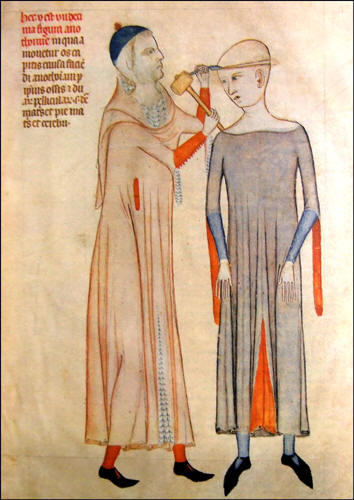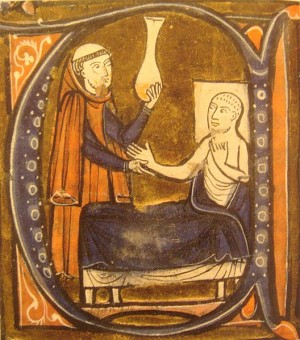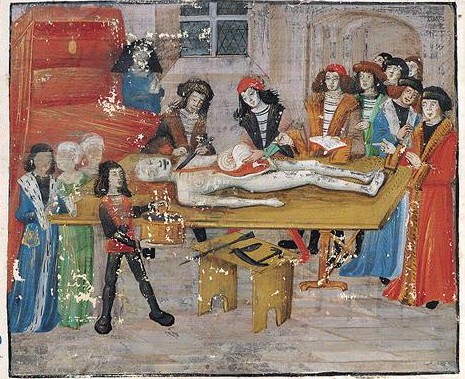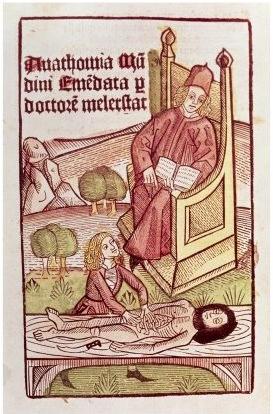Traveling within the World
Linking your favorite traveling artists across the globe
Medieval Medical Experiments
Medieval Medical Experiments

The Middle Ages has often been portrayed as a time of great ignorance for the study of medicine. For example, one popular site states that, “no new medical research was conducted, and no new practices were created. Physicians simply perpetuated the church-approved classical techniques developed by Galen and others that were preserved in ornately decorated, hand-copied texts produced by monks.”
Did medieval physicians try to learn about medicine and the human body? Did they try medical experiments? This article takes a look at the efforts by some medieval physicians to learn more about their craft, including by clinical observation and experimentation.
The first myth to be refuted is the idea that medieval physicians only relied on the writings of ancient writers such as Galen for their medical knowledge. While they often stated that it was important to read the writings of previous experts, it was just as (or even more) important to make use of one’s observations and experience. For example, the 12th century Jewish philosopher and physician Maimonides explained that:
The art of medicine rests both on experience and reasoning and the things which are known through experience are much more numerous than those known through reasoning. Since any individual’s experience is necessarily limited the physician must go beyond his experience and study prior physicians going back to Hippocrates and Galen – science is the root whereas the practical part is the branch and there can be no branch without a root.
Ibn al-Nafis, a Muslim physician from the 13th century, was more adamant in the need to base medical knowledge on experience rather than what he read. He explained “as regard the function of organs, we rely only on what is dictated by investigative observations and accurate research; not caring whether it conformed with, or differed from, the opinions of those who came before us.”
One example of how this practice comes from the year 1200, when a famine broke out in Egypt. While thousands of people died, it was also an opportunity for ’Abd al-Latif al-Baghdadi (d.1213) and other physicians to find out the answer to an anatomy problem. According to the writings of Galen the lower jaw bone was made up of two bones. Al-Baghdadi and the other medical experts disagreed, and with all these corpses around they thought of making a study of them. They arranged to see over two thousand skulls to observe their jaws before making their determination – all of them had a lower jaw made up of one bone, not two – and they then had a second group of physicians come in to verify their findings.
Ibn Zuhr, a twelfth-century physician in al-Andalus, noted that some of his readers might disagree with his opinions on which laxatives to use. So he wrote, “I will challenge them to one [contest]: let them utilize the medicines I mentioned in the same way I prescribed and utilize it in a different way. Then, the effects and side effects of each method are to be recorded. Certainly the experiment will either validate or invalidate my opinion whether I was then alive or dead.”
Medieval Medical Experiments on Humans and Animals
One of the best known physicians from the medieval world was Muhammad ibn Zakariya al-Razi (know in Europe as Rhazes). Born around the year 865, he was a musician and a money-changer until his 30s, before beginning to study medicine and other sciences in Baghdad. He wrote dozens of works and showed remarkable insight into how to perform medical care. In one work he describes the symptoms people get at onset of meningitis – “dullness and the pain in the head and neck continue for three and four and five days or more, and the vision shuns light, and watering of the eyes is abundant, yawning and stretching are great, insomnia is severe, and extreme exhaustion occurs…” and then goes on to say they can be prevented from developing the disease by bloodletting. Al-Razi explains that he created his own version of a medical experiment to figure out this answer:
For I once saved one group [of patients] by it, while I intentionally neglected [to bleed] another group. By doing that, I wished to reach a conclusion. And so all of these [latter] contracted meningitis.
Al-Razi is also the first medieval physician to record animal experimentation when he tested mercury on monkeys to see what level of dosage would be safe enough for humans. Other Muslim physicians were also willing to try various surgical techniques on animals, including apes, before they would perform them on humans. When Ibn Zuhr was learning how to perform a tracheostomy (where one cuts an opening into the neck to allow some to breath without the use of a mouth or nose) he decided to try one method on a goat:

I cut on the lung pipe (wind pipe, trachea) of a goat after incising the skin and the covering sheath underneath. Then I completely cut off the substance of the pipe an area just less than the size of a tirmisah (lupine seed). Then I kept washing the wound with water and honey till it healed and it (the animal) totally recovered and lived long time.
See also: Medical Care in Islamic Tradition During the Middle Ages
Understanding Medieval Drugs
When one reads medieval medical textbooks they will come across various recipes on how to treat various illnesses. They often involve making a complicated mixture of food, plants, animals or stones – many of them unusual. For example, in the 13th century Peter of Spain wrote this prescription for hair loss on the eyebrows: Wolf fun, in which hairs seem to sprout; from it a powder is made and mixed with oil of laurel and rubbed into the eyebrows.
Did these physicians check to see if such a medication would work? Several texts suggest that these writers did make attempts to check the accuracy of the concoctions. Peter of Spain goes on to write that for medicine you needed to have experimentation and he formed a set of rules that one should observe when checking to see if a medicine worked:
1. The medicine to be tested should be pure.
2. The patient should have the disease for which the medicinal is intended.
3. The medicine should be given alone.
4. The medicine should be the opposite of the disease
5. It should be tested many times.
6. It should be tested on the right body – ie. the body of a man, not the body of an ass.
See also Medieval Cures from The Alphabet of Galen
Dissection and Autopsies in the Middle Ages
Another popular myth about the Middle Ages was that physicians would not use dead bodies for medical research. Historians from the 19th century pointed to a papal bull by Pope Boniface VIII called Of detestable cruelty. Sent out in 1299, it excommunicated those who cut up a corpse and boiled off the skin – a funerary practice that was used to transport the skeletal remains of a person long distances. However, this papal prohibit was never intended to ban dissections and there were never any cases of people being sanctioned for the practice. The same is true for medieval Islamic physicians – many texts note the importance of being able to conduct dissections to better understand the human anatomy, and no writings exist that banned the practice in the Arabic world.
Dissection was still rare in the Middle Ages, as few people would be willing to have their deceased family members used as a cadaver. The most likely source of bodies came from condemned criminals. The Byzantine historian Theophanes (752–818) records how “an apostate from the Christian faith and leader of the Scamari, was captured. They cut off his hands and feet on the Mole of St Thomas, brought in physicians, and dissected him from his pubic region to his chest while he was alive. This they did with a view to understanding the structure of man. In this condition they gave him over to the flames.”
Meanwhile, in 1319 four medical students at Bologna were caught trying to exhume the grave of a criminal who was executed earlier that day so they could perform a dissection on him.By the later Middle Ages, those interested in anatomy would also look for the poor and elderly who had no family to give them a burial. Leonardo da Vinci himself performed more than 30 dissections, including that of a 100-year-old man he had met a Florentine hospital and befriended.
At the same time autopsies were also being performed by physicians to learn more about the causes of death. During the Black Death, the city of Florence financed autopsies on those who died from the plague, “in order to know more clearly the illnesses of their bodies”. Meanwhile, Johannes della Penna, a physician from Naples also performed autopsies on plague victims, finding that “some had a multitude of ulcers that were internal, in the chest and on the lungs, and that from these came the spitting of blood and they died rapidly. Others had them externally, having ulcers, spots and herpes that formed under the skin in the three principle glands.”
In Italy we can see more autopsies being done in the fifteenth-century. For example, in August of 1477, Fiamatta di Donato Adimari gave birth to a daughter. Several weeks later she became told her husband about an intense pain around her heart – two hours later she died. She was 25. Her husband, Filippo di Matteo Strozzi, a wealthy businessman, asked several physicians to perform an autopsy. He later wrote:
I had the body opened and among the others there to see it was Master Lodovico [di Maestro Piero dal Pozzo Toscanelli, a prominent Florentine physician], and he later said to me that he had found her uterus full of petrified blood, and that this caused her death. And in addition, her liver was in very bad shape, together with her lungs, which had begun to attack her kidneys. So that if she had not died of this illness, she would have fallen into consumption. Her death caused me great sorrow, because every day she pleased me with her many good qualities.
In her work Secrets of Women: Gender, Generation, and the Origins of Human Dissection, Katherine Park reveals that there were many cases of families getting autopsies done. One Florentine physician, Antonio di Ser Paolo Benivieni, was present for at least 18 autopsies, most of which were done for members of the leading families in the city – five of these were for women, and six for children. In these cases it seems that families wanted to know how their loved one died, or if the doctor treating them had made mistakes that led to their death.

While medieval physicians certainly did not follow the same practices that their modern counterparts do, and often adhered to medical beliefs that were clearly wrong, it is not true that they did not seek out to experiment and learn new things about their craft. Their writings make it clear that those who practiced medieval medicine understood that they could not only rely on the works of ancient physicians – they also had to seek knowledge through experience and sometimes by experimentation.
Tags:
Replies to This Discussion
Events
-
2014 is the Chinese Year of the Horse
February 17, 2026 at 12am to February 5, 2027 at 12am – where & how you choose
Birthdays
Birthdays Today
Birthdays Tomorrow
Important (read & understand)
Skype: Travelingraggyman
Email and Instant Messenger:
TravelerinBDFSM @ aol/aim; hotmail; identi.ca; live & yahoo
OR
Travelingraggyman @ gmail and icq ***

1AWARD UPDATES & INFORMATION
10,000 votes - Platinum Award
5,000 votes - Gold Award
2,500 votes - Silver Award
1,000 votes - Bronze Award
300 votes - Pewter Award
100 votes - Copper Award
Member of the Associated Posting System {APS}
This allows members on various sites to share information between sites and by providing a by line with the original source it credits the author with the creation.
Legal Disclaimer
***************We here at Traveling within the World are not responsible for anything posted by individual members. While the actions of one member do not reflect the intentions of the entire social network or the Network Creator, we do ask that you use good judgment when posting. If something is considered to be inappropriate it will be removed
Site Meter
This site is strictly an artist operational fan publication, no copyright infringement intended
Patchwork Merchant Mercenaries had its humble beginnings as an idea of a few artisans and craftsmen who enjoy performing with live steel fighting. As well as a patchwork quilt tent canvas. Most had prior military experience hence the name.
Patchwork Merchant Mercenaries.
Vendertainers that brought many things to a show and are know for helping out where ever they can.
As well as being a place where the older hand made items could be found made by them and enjoyed by all.
We expanded over the years to become well known at what we do. Now we represent over 100 artisans and craftsman that are well known in their venues and some just starting out. Some of their works have been premiered in TV, stage and movies on a regular basis.
Specializing in Medieval, Goth , Stage Film, BDFSM and Practitioner.
Patchwork Merchant Mercenaries a Dept of, Ask For IT was started by artists and former military veterans, and sword fighters, representing over 100 artisans, one who made his living traveling from fair to festival vending medieval wares. The majority of his customers are re-enactors, SCAdians and the like, looking to build their kit with period clothing, feast gear, adornments, etc.
Likewise, it is typical for these history-lovers to peruse the tent (aka mobile store front) and, upon finding something that pleases the eye, ask "Is this period?"
A deceitful query!! This is not a yes or no question. One must have a damn good understanding of European history (at least) from the fall of Rome to the mid-1600's to properly answer. Taking into account, also, the culture in which the querent is dressed is vitally important. You see, though it may be well within medieval period, it would be strange to see a Viking wearing a Caftan...or is it?
After a festival's time of answering weighty questions such as these, I'd sleep like a log! Only a mad man could possibly remember the place and time for each piece of kitchen ware, weaponry, cloth, and chain within a span of 1,000 years!! Surely there must be an easier way, a place where he could post all this knowledge...
Traveling Within The World is meant to be such a place. A place for all of these artists to keep in touch and directly interact with their fellow geeks and re-enactment hobbyists, their clientele.
© 2025 Created by Rev. Allen M. Drago ~ Traveler.
Powered by
![]()
